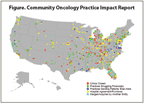How the Sequester Cuts Are Harming Oncology
Now is a critical moment for all involved in caring for cancer patients to engage in this national policy debate; numerous cancer advocacy organizations have already joined the effort to oppose the sequester cuts to oncology drugs.
The Sequester
In August 2011, Congress passed the Budget Control Act, which required Congress to agree to reduce the deficit by $1.2 trillion over a 9-year period-or if Congress failed to do this, automatic cuts known as “sequestration” would be implemented. Political gridlock ensued and the sequester cuts were enacted at the beginning of March 2013.

David Eagle, MD
The sequestration agreement predetermines varying levels of cuts for different sectors of the economy. Defense spending is affected the most. Separate areas of healthcare are now suffering differing levels of cuts. The National Institutes of Health have been mandated to make 8.2% across-the-board cuts for the remaining fiscal year. A 2% reduction will be applied to Medicare.[1]

Michael Diaz, MD
The Centers for Medicare and Medicaid Services (CMS) has applied the sequestration cuts to oncology in a drastic manner that grossly amplifies the magnitude of an already-problematic 2% cut. While CMS claims it is “unaware of any authority” to exempt cancer drugs from the sequester cuts,[2] it is likely that the agency could have mitigated the impact. CMS used its discretion to apply the 2% sequester cut to the entire amount that oncology clinics are reimbursed for drugs. This is despite specific guidance from the Office and Management and Budget (OMB) to “use any available flexibility to reduce operational risks and minimize impacts on the agency’s core mission in service of the American people. . . ”[3]
To comprehend the true impact of CMS’s decision requires an understanding of the formula for private office oncology drug reimbursement and the impact this formula has already had on private oncology groups. In 2003, the Medicare Modernization Act (MMA) directed that oncology drugs be reimbursed at average sales price (ASP) + 6%. Included in this formula is a “prompt pay” discount; this discount is provided to distributors by drug manufacturers and is not passed on to oncology practices. The net effect, for oncology practices, is that ASP + 6% functionally becomes ASP + 4%. In addition, manufacturer price increases are not adjusted in the Medicare payment formula until after a 6-month delay. Since many manufacturers do raise prices, the margin on chemotherapy is further reduced. This margin is important because it covers the cost of operating chemotherapy preparatory facilities, as well as of ordering and managing a drug inventory; the cost of storage, waste, and disposal of drugs; and otherwise uncompensated services necessary to operate an oncology clinic.
Under sequestration, CMS applied the 2% cut to the entire 106% drug reimbursement, not to the 6% margin as would have been more appropriate. As a result of this and other technical details, the 2% cut lowers ASP + 6% to ASP + 4.3%. Thus, the 2% cut is magnified to 28%, a huge economic blow to already struggling community practices. As previously outlined, practices do not truly receive a 6% margin on drugs to begin with, so the proportional 28% reduction is an underestimate for the vast majority of practices.
What Will Be the Consequences?
In exchange for lower reimbursement for drugs under the MMA in 2003, Medicare was supposed to pay more for oncology services such as chemotherapy infusion. However, since 2004, CMS has reduced infusion code payments by more than 35%. In addition, CMS never enacted treatment planning codes mandated by the MMA. On the record, CMS and other payers state a desire to pay oncologists for “what they do.” This stated desire has been far more rhetorical than real. Over the past several years, private insurance payment amounts for drugs have been reduced without compensatory increases in payments for oncology cognitive services or the facility costs through which oncology offices coordinate care and provide supportive services to frail seniors.
FIGURE

Community Oncology Practice Impact Report
These combined Medicare and private payer reimbursement cuts have already had a profound impact on community cancer clinics. The Community Oncology Alliance (COA) has compiled a practice impact report detailing the impact of these changes.[4] Over the past 4 ½ years, 1,254 clinics have either closed, merged, joined hospital systems, sent patients to other facilities, or struggled financially (Figure). These effects have had an impact not only on the clinics themselves, but on cancer patients everywhere. Many rural clinics have never been replaced, forcing frail cancer patients to travel long distances for care.
Moreover, as the site of care transitions to hospital facilities, the cost of care also increases-for patients, for private insurers, and for Medicare. A recent Milliman report analyzed the cost of care by site for Medicare beneficiaries. The monthly cost of cancer care was $4,361 in the physician office setting compared with $4,981 in the hospital outpatient setting.[5] A similar study by Avalere examined the cost of care by site of service for privately insured patients. The average cost of an episode of care was $28,000 in a private physician office compared with $35,000 in a hospital outpatient department.[6]
The sequester cuts enacted at the beginning of March are now being applied to chemotherapy reimbursement as of April 1, 2013. Understanding that many treatments provided in a private physician office now constitute a financial loss to the practice, many practices are being forced to send their patients to other settings for chemotherapy infusions. The news media, both international and domestic, have recognized the avoidable harm that this creates for seniors. Leading US newspapers, Sunday television talk shows, weekday news television programs, and European newspapers and television news programs have all included segments specifically on the impact of the sequester cuts on cancer drugs.
What Are the Solutions?
While CMS claims it does not have discretion to apply the sequester cuts to cancer drugs in another manner, policy makers on Capitol Hill are challenging this contention. Congressman Pete Sessions, Chairman of the House Rules Committee, with approximately 130 other representatives cosigning, have sent a letter to CMS clarifying the application of the sequester to cancer drugs. First, the letter asks whether CMS has any statutory authority to reduce Medicare Part B drug reimbursement, since the amount is specified in the MMA. Second, the letter asks why CMS chose not to follow the OMB memorandum to use flexibility in applying the sequester cuts in a manner that minimizes the impact on Medicare beneficiaries. The letter also asks for more information from CMS regarding the impact from a global cost perspective. Will the reduced access to cancer clinics force patients into higher-cost sites of care?
Congresswoman Rene Ellmers (R, NC) has introduced a bill, HR 1416, that would exempt cancer drugs from the sequester cuts. If passed, this legislation would supersede any perceived authority by CMS to apply the sequester cuts in their current format.
Now is a critical moment for all involved in caring for cancer patients to engage in this national policy debate; numerous cancer advocacy organizations have already joined the effort to oppose the sequester cuts to oncology drugs. Understanding the mechanics of ASP reimbursement, the effects of further cuts to ASP on oncology offices, and the higher cost of care in the hospital setting is critical to fighting the sequester cuts to oncology drugs that are harmful to patients-to say nothing of being self-defeating with regard to the sequester’s original intent of producing budgetary savings.
References:
References
1. McDonoush J. Budget sequestration and the U.S. health sector. N Eng J Med. 2013;368:1269-71.
2. Kliff S. Will the sequester’s cancer cuts get fixed? The Washington Post. Retrieved April 10th, 2013 Available from: http://www.washingtonpost.com/blogs/wonkblog/wp/2013/04/04/will-the-sequesters-cancer-cuts-get-fixed/?print=1. Accessed April 10, 2013.
3. Office of Management and Budget. OMB M-13-03, “Memorandum for the heads of executive departments and agencies.” Available from:
. Accessed January 14,2003.
4. Community Oncology Alliance. Community Oncology Cancer Care Practice Impact Report: documented impact on community oncology practices. Available from: http://www.communityoncology.org/pdfs/community-oncology-practice-impact-report.pdf
5. Site of service cost differences for Medicare patients receiving chemotherapy. Milliman Client Report. Oct 19,2011. Available from: http://publications.milliman.com/publications/health-published/pdfs/site-of-service-cost-differences.pdf.
6. Total cost of cancer care by the site of service: physician office vs outpatient hospital. March 2012. Available from: http://www.communityoncology.org/pdfs/avalere-cost-of-cancer-care-study.pdf. Accessed April 19, 2013.
Oncology Peer Review On-The-Go: Cancer Care Management During the COVID-19 Pandemic
October 28th 2020The newest episode of Oncology Peer Review On-The-Go speaks with 2 authors of an article from the October Issue of the journal ONCOLOGY focusing on effective cancer care management during the coronavirus pandemic.